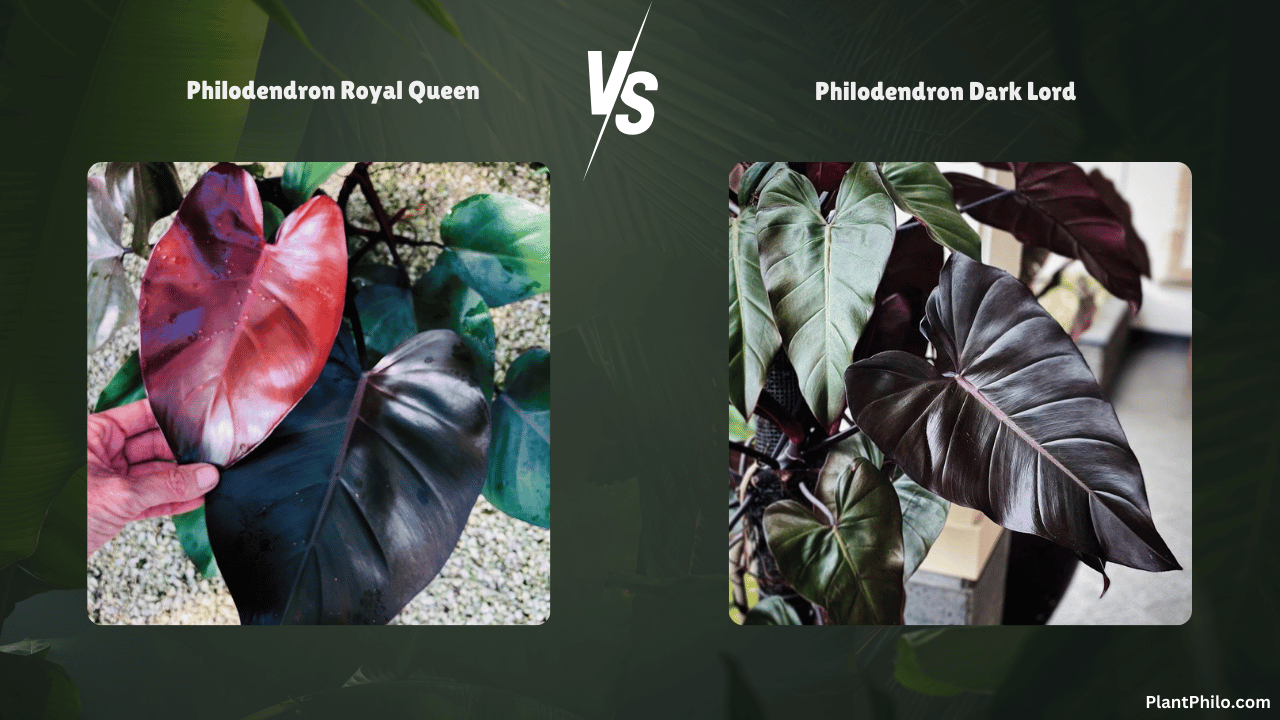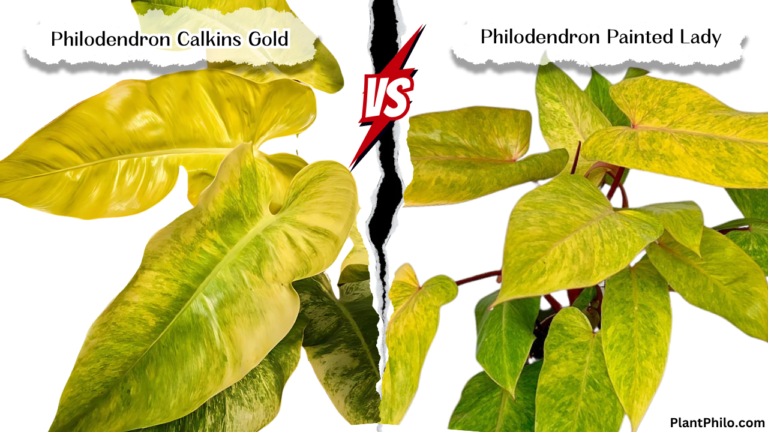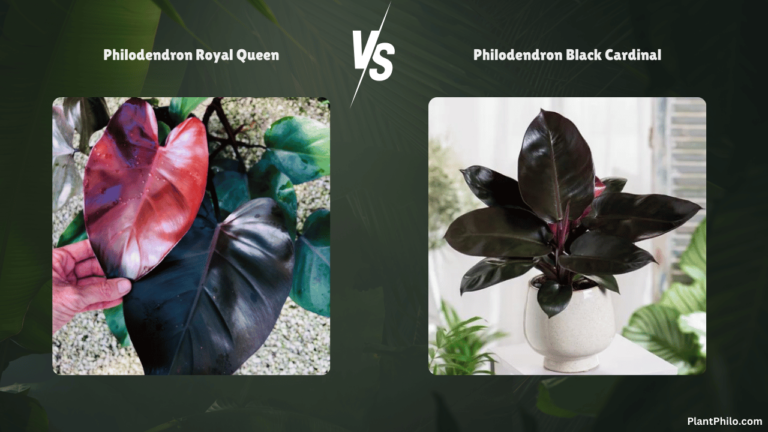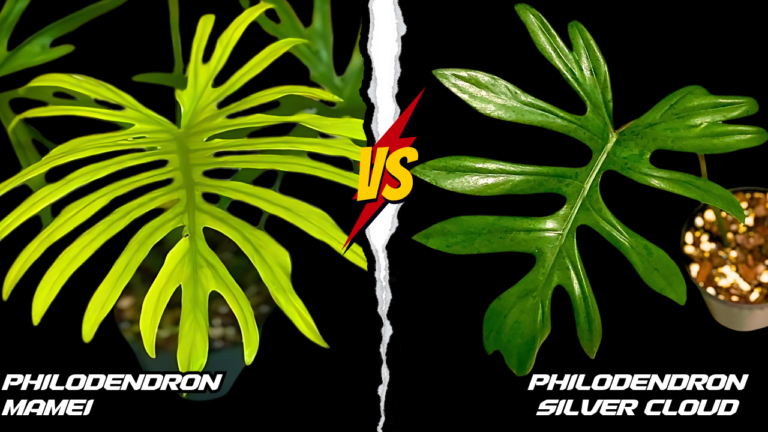Philodendron Royal Queen vs Dark Lord: Choosing Your Dark Royalty
Philodendron Royal Queen vs Dark Lord? If you’re captivated by the allure of deep, dark foliage, you’ve likely encountered these two enigmatic beauties. But their regal names and similar appearances can lead to a royal dilemma: which one deserves a place in your indoor kingdom?
Let’s embark on a horticultural journey, delving into the subtle distinctions between these two dark-leaved monarchs. We’ll dissect their care needs, growth habits, and unique characteristics, empowering you to make an informed decision and crown the perfect dark royalty for your green haven.
Comparison Table: Philodendron Royal Queen vs Dark Lord
| Feature | Philodendron Royal Queen | Philodendron Dark Lord |
| Botanical Name | Philodendron erubescens ‘Royal Queen’ | Philodendron erubescens ‘Dark Lord’ (or ‘King of Spades’) |
| Common Names | Royal Queen Philodendron | Dark Lord Philodendron, King of Spades Philodendron |
| Origin | Cultivar | Cultivar |
| Growth Habit | Self-heading, can become vining with maturity | Vining, climbing with support |
| Leaf Shape & Size | Large, ovate to paddle-shaped, up to 12-16 inches long | Elongated, triangular, arrow-shaped, up to 12 inches long |
| Color | Deep green with a subtle burgundy sheen, new leaves often reddish | Dark olive green to almost black, often with subtle variegation |
| Light Requirements | Bright, indirect light to maintain deep color; tolerates low light but may lose vibrancy | Bright, indirect light to encourage growth and maintain dark color |
| Watering Needs | Water when top 2-3 inches of soil are dry | Water when top 2-3 inches of soil are dry |
| Humidity | Appreciates higher humidity but tolerates average levels | Appreciates higher humidity but tolerates average levels |
| Fertilizing | Balanced liquid fertilizer diluted to half-strength, monthly during growing season | Balanced liquid fertilizer diluted to half-strength, monthly during growing season |
| Common Pests & Diseases | Mealybugs, scale, spider mites, root rot (if overwatered) | Mealybugs, scale, spider mites, root rot (if overwatered) |
| Propagation | Stem cuttings in water or soil | Stem cuttings in water or soil |
| Toxicity | Toxic to pets and humans if ingested | Toxic to pets and humans if ingested |
| Petiole | Long, sturdy, reddish | Long, slender, reddish |
| Stem | Thick, upright, may become vining with age | Thin, vining, can develop aerial roots |
| New Leaf Color | Reddish, maturing to deep green with a burgundy sheen | Coppery or bronze, maturing to dark olive green or almost black |
| Air Purifying | Moderate air purifying qualities | Moderate air purifying qualities |
| Overall Difficulty | Easy to care for | Moderately easy to care for |
| Mature Size | Can reach 3-4 feet tall and wide, may vine with maturity | Can reach 6-8 feet with support |
In-Depth Comparison: Beyond the Darkness
Growth Habit: The Queen’s Stature vs. The Lord’s Climb
While both plants share a penchant for dramatic foliage, their growth habits offer a subtle contrast. The Royal Queen, true to its name, maintains a regal, upright posture, forming a compact, self-heading plant. It’s like a queen holding court, commanding attention with its presence.
However, as it matures, it might surprise you with a bit of vining behavior, sending out shoots in search of new territories to conquer.
The Dark Lord, on the other hand, is a climber from the start, eager to ascend with the help of a moss pole or trellis. It’s like a lord surveying his domain, reaching for new heights and exploring every nook and cranny.
Leaf Shape & Color: A Study in Dark Elegance
Both plants showcase stunning dark foliage, but with distinct shapes and textures. The Royal Queen boasts large, ovate to paddle-shaped leaves that can reach an impressive size.
Its deep green leaves often have a subtle burgundy sheen, especially when exposed to bright light. New leaves emerge in a vibrant red, adding a touch of fiery drama to its otherwise serene appearance.
The Dark Lord, true to its name, sports elongated, triangular leaves with a sharp, arrow-like tip. Its foliage ranges from dark olive green to almost black, often exhibiting subtle variegation or mottling. It’s like a shadowy figure, cloaked in mystery and allure.
Light & Water: Nurturing Needs
Both plants thrive in bright, indirect light, which helps them maintain their deep colors and encourages healthy growth. While they can tolerate lower light conditions, their colors might fade, and their growth might slow down.
When it comes to watering, both plants prefer their soil to dry out slightly between waterings. Allow the top 2-3 inches of soil to dry out before reaching for your watering can. Remember, overwatering can lead to root rot, so it’s better to underwater than overwater.
Humidity, Fertilizing & Pests: Shared Traits
Both the Royal Queen and Dark Lord appreciate a humid environment, although they can tolerate average household humidity with a little extra care. Misting, pebble trays, or a humidifier can all help boost humidity levels and keep your plants looking their best.
Both plants benefit from a monthly dose of diluted liquid fertilizer during their growing season. They’re also susceptible to the same common houseplant pests, such as mealybugs, scale, and spider mites. Keep a watchful eye and address any infestations promptly.
Propagation: Expanding Your Kingdom
Both plants can be propagated through stem cuttings. Simply take a healthy cutting with at least one node and a few leaves and place it in water or moist soil. With a little patience and the right conditions, roots will develop, and you’ll have a new plant to share or add to your collection.
Toxicity: A Word of Caution
While these plants are visually stunning, they’re not meant for consumption. Both contain calcium oxalate crystals, which can cause irritation and swelling if ingested. So, admire their beauty from a safe distance and keep them out of reach of pets and curious children.
Overall Difficulty: Royal Ease vs. a Touch of Challenge
The Royal Queen is generally considered easy to care for, making it suitable for plant enthusiasts of all levels. The Dark Lord, while still manageable, can be a bit more sensitive to fluctuations in humidity and light. It might require a bit more attention and experience to keep it thriving.
FAQs: Addressing Your Royal Queries
What’s the main difference between the Royal Queen and Dark Lord?
The main differences lie in their leaf shape, color, and growth habit. The Royal Queen has large, ovate leaves with a burgundy sheen and a self-heading growth habit, while the Dark Lord has elongated, triangular leaves with a dark olive to almost black color and a vining habit.
Which plant is bigger?
The Philodendron Dark Lord typically grows larger than the Royal Queen, reaching up to 6-8 feet with support.
Can I grow these plants in low light?
They can tolerate low light, but their growth will slow down, and their colors might fade.
How often should I fertilize?
Fertilize monthly during the growing season (spring and summer) with a balanced liquid fertilizer diluted to half-strength.
What’s the best way to increase humidity?
Misting, pebble trays, and humidifiers are all effective ways to increase humidity.
Can I propagate these plants from leaf cuttings?
No, these Philodendrons cannot be propagated from leaf cuttings alone. You’ll need a stem cutting with at least one node.
How do I know if my plant needs repotting?
If the roots are growing out of the drainage holes or the plant is becoming rootbound, it’s time to repot.
Can I grow these plants outdoors?
Yes, in warm climates with indirect light, but protect them from direct sun and extreme temperatures.
Are these plants safe for pets?
No, both plants are toxic to pets and humans if ingested.
Which plant is more expensive?
Both plants can be quite expensive due to their rarity and popularity, but prices can vary depending on the size and variegation of the plant.
Conclusion: Choosing Your Dark Royalty
Choosing between the Philodendron Royal Queen and Dark Lord is a matter of personal preference and the ambiance you want to create in your space.
If you crave a regal, self-heading plant with large, deep green leaves and a touch of burgundy, the Royal Queen might be your ideal choice. If you’re drawn to the allure of dark, velvety foliage with subtle variegation and a vining habit, the Dark Lord will be a great choice for you.





